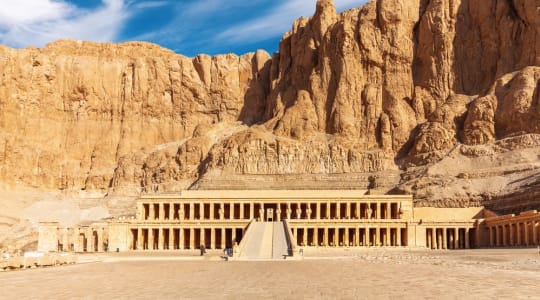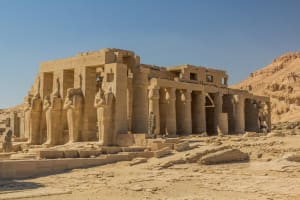
The Temple of Hatshepsut is a mortuary temple located on the west bank of the Nile in Luxor, Egypt. It was built during the 18th dynasty of ancient Egypt for the pharaoh Hatshepsut, who ruled from 1479-1458 BCE. The temple was designed by the architect Senenmut and is considered one of the finest examples of ancient Egyptian architecture.
The temple is dedicated to the god Amun and contains three terraces that rise against the cliffs of Deir el-Bahri. The first terrace is home to a large courtyard with two rows of columns, and the second terrace contains a portico with two rows of columns as well. The third terrace is the main sanctuary, which includes a hypostyle hall with 23 columns, a vestibule, and three chapels dedicated to Amun, Anubis, and Hathor.
The temple was abandoned after the pharaoh's death and fell into disrepair. It was later used as a Coptic Christian monastery, and some of the structures built by the monks still remain. The temple was rediscovered in the 19th century by the French Egyptologist Jean-Francois Champollion and has since undergone extensive restoration.
The Temple of Hatshepsut is notable for its use of natural light and the way it blends into the surrounding landscape. The temple's unique design and historical significance have made it a popular destination for tourists visiting Luxor.
Explore Near Temple of Hatshepsut
Discover 5 attractions, 5 cities, and 1 airport within 75km. Perfect for planning day trips, finding connecting flights, or discovering new destinations to explore during your visit.
Nearby Attractions & Places to Visit
5 destinations within 521m - 5.4km from your location





Nearby Cities Worth Exploring
5 destinations within 5.6km - 48.9km from your location
Airports Near Temple of Hatshepsut
1 destination within 12.5km from your location
Cross-Border Adventures Near Temple of Hatshepsut
Discover cross-border adventures near Temple of Hatshepsut. Explore neighboring countries with similar attractions and extend your travel experience across borders.




